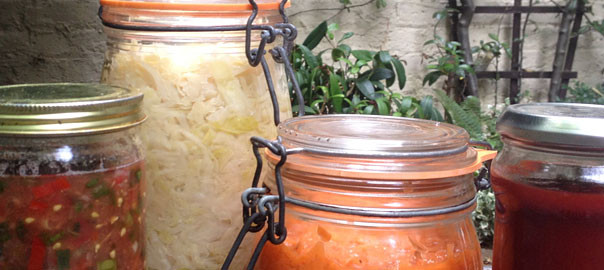How many fermented foods do you regularly consume? Perhaps you eat them daily as a matter of course, or your diet may already include a number of such foods but you aren’t even aware of it. The topic of fermented foods has received a steady stream of positive worldwide media more recently. Dietary regimes incorporating fermented foods have gained in popularity and been lauded for their theoretical health benefits, primarily in terms of gut and immune support.
Indeed its rather ‘full circle’ as fermented foods, once a staple of the human diet since ancient times, and also adopted in certain cultures for medicinal purpose declined in popularity. It is marvellous to see these foods now finding favour and getting a lot of positive publicity, there are many merits to the health benefits of such foods – when done properly.

This article is also a reminder that achieving good gut health is not just vital for a healthy digestive system. Our gut is intimately linked with our immune system and all other bodily functions, and this includes producing around 90% of the neurotransmitter serotonin, which has the most profound effect on mood.
This article is kindly provided by nutritional therapist Katie Clare, who explains more on this fascinating topic. Katie has previously written articles for this blog on the emerging field of Nutrigenomics and also conversion efficiency inhibitions relating to Essential Fatty Acids. So please read on to understand more about fermented foods.
The Importance of Gut Health
The gut is now often referred to as a foundation pillar of health for the body, and the digestive system as ‘the mother’ of the body, as it feeds all of the other organs. We know that digestive health is of prime importance to overall health, and is often the first place to focus on in a functional medicine programme.
When accessing gut health, nutritional therapy is particularly concerned with:
- The health of the gut lining (preventing or repairing leaky gut);
- The body’s ability to produce stomach acid and digestive enzymes so that we can assimilate food;
- The levels of secretory IgA (a first line of antibody defence);
- The gut ecology.
Gut Flora
It is gut ecology and particularly gut bacteria that have predominantly been in the spotlight in recent years. Beneficial bacteria have been linked to weight loss, allergy reduction, mood, skin issues and many more complaints. Sales of live native bacterial products (formerly termed ‘probiotics’) have rocketed, but so too has interest in ‘fermented foods’ – foods that contain, and have been transformed by, live beneficial bacteria.
Fermentation and Fermented Foods
Fermentation is an ancient process, preceding human history. It also occurs in the cells of our bodies. It is the transformative action of microorganisms (bacteria or yeasts) as well as the enzymes they produce. People have long studied and played with the technique which is both a science and an art. Fermented Foods are a collaboration with microbes; humans manipulate the environmental conditions to select the bacteria they want to thrive, then sit back while the bacteria does all the work. We add the flavours and the finishing touches to make unique eatables. A culinary symbiosis of bacteria and man!
It is estimated that a third of our cuisine globally is fermented – yoghurts, cheese, tofu, bread, vinegar, alcohol and so on, although of course many items today are now highly processed, made as quickly as possible and pasteurised to kill off any bacteria. The word ‘ketchup’ comes from an old Indonesian word ‘Ketjap’ which is a fermented sauce, and until only a couple of hundred years ago all breads would have been made from a sourdough starter culture, using beneficial bacteria.
Through time people have fermented for many reasons; to produce alcohol, for preservation and also for the flavours. Recently, in a time of environmental awareness and concern, some people choose to ferment to reduce their reliance on refrigeration.
Lactic Acid Bacteria
The bacteria that we mainly want to encourage into our products in order to access their health benefits are lactic acid bacteria, also known as or lactobacilli or ‘LAB’. The term lacto-fermentation is also used to describe the work they do. These bacteria are found on all plants but in relatively low numbers due to other types of bacteria dominating in the natural environment. Fermenting the food means eradicating the other types of bacteria and allowing the lactobacilli to thrive.
As the LAB transform their ingredients they produce nutritional benefits. Phytate bonds are broken away making the minerals more accessible, proteins are taken apart into peptides and amino acids, reducing their allergenic potential. It is as though the ingredients were predigested for us! B vitamins can be increased (B1, B2 and B3 in particular) and anti nutrients or toxins such as nitrates and also oxalates, related to kidney stones, are removed.
Yoghurt & Sauerkraut
Yoghurt is a great example of a fermented food that is freely available, but not everybody wants to eat dairy. Thankfully Rhythm Health have recently brought out a coconut kefir beverage. Sauerkraut (fermented cabbage) is another classic example of a fermented food, but most of the sauerkraut now available in shops today has been pasteurised and so does not contain live bacteria. This is a really important point. You need to look out for ‘raw’ or ‘live’ sauerkraut available in health food shops or learn to make your own.
This has been called ‘ the fermentation revival!’ Small brands producing sauerkraut and other relishes have started to pop up. Check out the company ‘Cultured Probiotics (Raw Foods)’ for a great range.
Traditional Sauerkraut Recipe

How do I make sauerkraut? I am asked this quite a lot. Probably because I am always recommending that everyone eats it! Sauerkraut is German for ‘soured cabbage’. The beneficial bacteria in this relish do turn the plain green vegetable into an interesting, slightly sour, tangy flavour. It’s amazing! Everybody wants to make raw sauerkraut these days, so let’s get started!
Ingredients:
1kg green cabbage, quartered, cored and roughly shredded.
1 tbsp. sea salt
4 tbsp. whey (or use an extra tbsp. sea salt)
plus 1 tbsp. of either caraway seeds, chopped dill or juniper berries,
or a mix, as you like
Method:
Add the salt to the bowl of cabbage. Using a rolling pin or a wooden hammer to pound the cabbage. It is best to time yourself and do this for six to ten minutes. This is a really important part of the process. Put a couple of your favourite tunes on and bash!
Add the whey, if using it, and the herbs or spices. Mix thoroughly.
Transfer to a wide mouth jar and pack in the mixture. This is another important step. Keep pushing down with a rolling pin or spoon to ensure that you get all of the air out and you are submerging the vegetables in their own juices.
Leave a couple of cm space at the top. Seal the jar and leave out for three weeks. You will need to release the gas from the jar by slightly opening the lid, every day or so for the first week.
Flavour Variations:
The recipe above is for a basic, traditional relish. Once you understand the process you can start to add all sorts of other vegetables.
Enjoy! You can see the full recipe including additional tips and recipes such as ‘Kimchi’ (spicy Korean relish) and Tomato Pepper Relish by following the link to the relevant page on my website further below.
By Katie Clare
mBANT CNHC
 Katie Clare is a registered nutritional therapist – She runs courses on food fermentation, and is available for consultations, on nutrition and wellbeing in Islington, where she is a resident nutritional therapist at Neal’s Yard Therapy Rooms. She also has a virtual practice and is available via Skype. Katie is a member of the British Association for Applied Nutrition and Nutritional Therapy (BANT) and registered with the Complimentary and Natural Healthcare Council (CNHC).
Katie Clare is a registered nutritional therapist – She runs courses on food fermentation, and is available for consultations, on nutrition and wellbeing in Islington, where she is a resident nutritional therapist at Neal’s Yard Therapy Rooms. She also has a virtual practice and is available via Skype. Katie is a member of the British Association for Applied Nutrition and Nutritional Therapy (BANT) and registered with the Complimentary and Natural Healthcare Council (CNHC).
With many thanks to Katie for this wonderful article and recipe. I hope it has inspired some of you to try more fermented foods – if you don’t already! Katie has provided some helpful links below, plus there are links to the pages on her website relating to fermented foods and her previous articles on this blog.
If you have any questions for Katie (or me) about fermented foods, or would like to share your own experiences and recipes do please let us have these by using the ‘leave a reply’ option below. And remember – fermented foods are great and healthy options to add to the diet off the whole family.
If you have any questions regarding this article, any of the health topics raised, or any other health matters please do contact me (Amanda) by phone or email at any time.
Amanda Williams, Cytoplan Ltd
amanda@cytoplan.co.uk, 01684 310099
RELEVANT LINKS:
Suggested links from Katie Clare:
Rhythm Health Drinks
Cultured Raw Foods
The website of Katie Clare:
Traditional Sauerkraut Recipe in full
What is Fermentation & its Benefits?
Other Reading on Fermented Foods:
Nutraingredients on Fermented Foods
Relevant Cytoplan Blog Articles:
Vitamins for the Brain
Are your Tummy Microbes making you Melancholic?
Blog Articles by Katie Clare:
Nutrigenomics – Where Nutrition meets Genetics
Essential Fatty Acids – Omega 3 & Conversion Efficiency Inhibitions
Last updated on 2nd February 2016 by cytoffice



I am a fan of kimchi and yogurt. An odd combination but the spice and somehow sweet-sour taste of yogurt blends well for my taste.